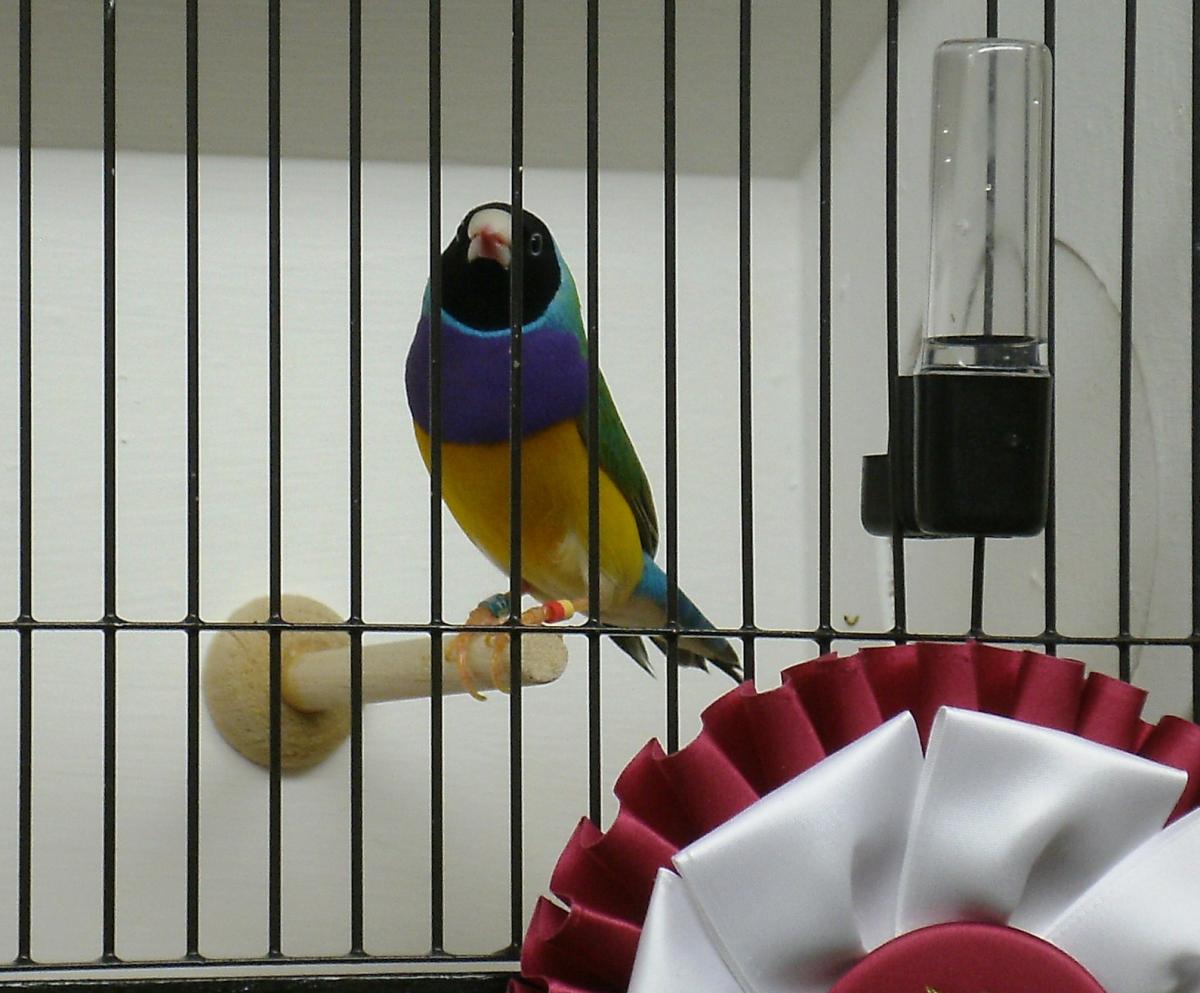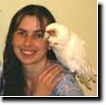Finalizing Selection of Breeding Pairs
Kristen Reeves, Meadowlark Farms Avian Supply, Inc.
It’s time to pair our Gouldians for breeding. Before we put them together, it is important to make a final review our choices and choose only the absolute best birds for pairing. While compatibility is key, we also need to be sure we are breeding IN the good traits and breeding OUT the bad. It is important to breed to IMPROVE your stock. Carefully choosing which birds to pair will give us more robust birds with stronger immune systems and better overall health. In addition, we also improve the conformation & color. While mutation colors are nice, producing them is not always in the best interest of our flocks. It is important for the success of the species to pair wisely to produce only the strongest birds that meet approved standards.
Everyone has their own idea of what a “good” bird should look like and what we prefer as breeders. Pretty color is wonderful, but genetic defects can destroy the fine line of a “good” Gouldian. For those of us who show our birds, we have a standard to meet. In the USA, we follow the National Finch & Softbill Society’s guidelines below (spelling & grammar corrected for easier reading). As Gouldian breeder (primarily) for over 17 years, I disagree with a few of these points and have my reasons for my disagreement. However, I still use these standards as a guideline and produce birds to meet these standards and to strengthen the species in captivity. Whether you show your birds, or keep them merely as pets, it is important to pair them wisely. This information applies to ALL breeders; pet breeders & show breeders alike.
“The Official Gouldian Finch Standard
Approved by the National Finch and Softbill Society March 1986 (updated 2009, 2014)
Overall:
The head should be nicely rounded with eyes set on the center line of the head. The body should be approximately 5 1/2", or 14cm. The body shape should be slightly tapered from the shoulders to the tail. The Gouldian Finch body must be substantial without being overly robust. The Gouldian Finch must never be a snaky bird. The line from the beak over the crown, nape back, rump and tail should be smooth and complete without breaks. The line from the lower mandible, over the chin, throat, chest, abdomen, vent, and to the tail should flow evenly and smoothly. Faults in conformation would include drooped tails, pouted (overly broad) chest, nipped necks and cocked tails.
The wings should be carried evenly and held close to the body. The tips of the wings should meet evenly at the tail and should not droop or cross.
In conformation, the tail is of great importance. Tail feathers should be of equal length and held evenly. The [TWO] central pin tail feathers must be elongated, separated, and running parallel with each other. These pin tail feathers, however, should be as long as possible with other tail feathers being in proportion to the body.
General Standard for Hens:
Hens will differ from the cocks in that the two central pin feathers of the tail will not be as long. The hen will tend to be a little more robust than the cock.
[FOR ALL]
The condition of the Gouldian Finch is of special significance, as this bird normally holds a good appearance, and the degree of difficulty is not great in keeping the bird in top condition. The Gouldian Finch must be immaculate with no soiled or frayed feathers. There must be no visible pin feathers. Missing toes, nails, or damaged or missing feathers are show faults and will count heavily against the bird.
COLOR AND MARKINGS
The National Finch and Softbill Society consider conformation to be of primary importance in the Finch Standards. Color and markings are ordinarily assigned 20 points as a guideline in judging. However, for the Gouldian Finch, color takes on an added importance and is assigned 30 points. Evenness and intensity of color are usually dominant considerations in the Gouldian Finch.
Color Standard for Red Headed Cock -
The forehead, crown and ear coverts will be deep scarlet red, which should be even, with no black or orange flecking. Chin and throat deep black, with a thin border of black continuing around the head. This boarder is ringed by a second line of royal blue, which extends and merges into the green of the side of the neck and mantle. The red, black, and royal blue markings should be sharply delineated from the chest color. Wing coverts should be of dark grass green with a slight glossiness. The primaries should be dark gray, almost black, with a lighter edging to the flight feathers.
The deep violet breast should extend from the royal blue throat band to the line funning across the chest at the level of the lesser wing coverts. This line should be clear cut and have a reddish tinge. Below this line and running over the abdomen and flanks, the colors should be deep buttercup yellow gradually finding to white in the area of the vent. The back should have a blue band, which merges on the head with the grass green of the mantle and back. The area should carry a gold suffusion, more intense on the mantle and approaching the rump. The rump should be royal blue. The under tail coverts should be clear white, while the upper tail coverts will be light sky blue. Some white frosting of the feather edges acceptable. The tail will be black.
The bill should be pearl white and the tip either rose or yellow. The legs should be flesh colored and the nails horn colored.
The eyes should be black with a thin flesh colored eye ring.
Color Standard Black Headed Cock –
Same as for Red headed, but the forehead, crown, ear coverts, chin and throat should be deep black with a slight glossy sheen. A line of royal blue at the edge of this black extends from the throat right around the back of the head. The edges between the blue band and the black should be sharply defined. On the throat, the line of blue should be sharply defined from the chest color, but should extend and merge into the green of the side of the neck and the mantle.
Color Standard Orange Headed Cock -
As for Red headed cock, but red is replaced by either a golden orange or a deep buttercup yellow.
Color Standard White Breasted Cock -
As for normal cock, but the chest violet is replaced by clear intense white, with no flecking.(a true white will remain white when an LED light is shown on it – lesser whites will look purplish under LED lighting).
Color Standard for Hens:
As for the male coloration except that chest violet (of the redheaded, black headed and orange headed varieties) will be much more pale, the mantle and black lack the gold suffusion, and the whole plumage is duller and lacks the glossiness of cocks.
DEPORTMENT AND PRESENTATION (5 POINTS)
The Gouldian Finch being a well domesticated bird, should be quite calm on the perch. Nervous birds will be faulted. The judge should be able to use a pointer without overly disturbing the bird.”
With that stated, I have to reiterate the importance of your pairings. Ultimately, what they are shaped like (conformation), their overall health (breeding IN health & robustness), their color (normals vs. mutations) and their pleasing appearance is up to you and how you pair them. I'd hope you'd prefer to perfect your lines to also include good conformation that meets the standard above!
My Observations –
Over the years, I have carefully chosen pairs and notated specific features in an effort to breed IN the good and breed OUT the bad. As a result of this research, I’ve found some very interesting results.
 When I first started breeding Gouldians some 17+ years ago, I had no idea there was such a thing as a “standard”. I purchased the prettiest birds I could find at a price I could afford. Unfortunately, not long after purchasing these birds, I learned about standards. After reading the standards, I took a long hard look at what I had here and decided to see if there was a way to produce birds that met the standard yet still appealed to my sense of God created beauty. My first course of action would be to correct flat heads, narrow breasts, long beaks, short tail wires in the cocks, and speckled masks in both the cocks & hens. I also needed to breed out the full outline of black surrounding some of my cock’s red masks. All of which would be considered faults on the show bench. I only had two unrelated pairs so I didn’t have much to work with – determination will get your everywhere.
When I first started breeding Gouldians some 17+ years ago, I had no idea there was such a thing as a “standard”. I purchased the prettiest birds I could find at a price I could afford. Unfortunately, not long after purchasing these birds, I learned about standards. After reading the standards, I took a long hard look at what I had here and decided to see if there was a way to produce birds that met the standard yet still appealed to my sense of God created beauty. My first course of action would be to correct flat heads, narrow breasts, long beaks, short tail wires in the cocks, and speckled masks in both the cocks & hens. I also needed to breed out the full outline of black surrounding some of my cock’s red masks. All of which would be considered faults on the show bench. I only had two unrelated pairs so I didn’t have much to work with – determination will get your everywhere.
I began pairing for color FIRST. I bred out the speckled masks by pairing ONLY normal colored birds with good clean masks. Those pairings also effectively removed the black line surrounding a red or yellow head cock mask. Any birds with speckled masks were removed from my breeding program. As a result, I also noticed more intense body color on both cocks & hens.
Generally speaking, the HEN tends to be the determining factor when it comes to putting SIZE AND CONFORMATION on the offspring of small, narrow, less than robust cock birds. Because hens tend to be more robust in body to begin with, they also impart that to their MALE offspring. Of course not every cock chick will receive his mother’s “big girl” genes, but he will have them in his genetic makeup and may impart those genes to his own offspring. It
Heads were a bit more difficult. It became obvious quickly that pairing flat headed birds was not going to result in round heads. I needed to add “good” birds to my less than stellar flock in order to produce rounder heads. It started with a single stunning hen. While at a local show, I saw a hen I thought was the most beautiful Gouldian I had ever seen. She had great shape. Her colors were bright and glossy – even for a hen. I bought her. Instinct told me to pair her with a smaller cock bird whose decent conformation had won him many places on top bench, but who would never win best in show due to his size. That pair was the beginning of a huge project to improve my stock.
It took several years to breed out the flat heads and long beaks. I personally prefer a short, tight beak. I want a slight arch on the top – like a “Roman nose”, but not so arched that the beak looks out of proportion to the head. I want the curve and length to form a smooth curved line from tip of beak over the top of the rounded head. Beak shape is harder to breed out. You must have good tight beaks to start with and BOTH parents must have the beak you are looking for. It can take several generations to get the beak shape you prefer.
Once I had a few “good” birds to breed, I decided my priority would be to preserve the NATURAL colors, then add some size to the birds. I found pairing larger hens to smaller cocks worked well to produce >50% offspring with the size I was working towards. The remaining birds were sold as pet quality.
Side Note: Something I learned during this research is that there are many differences between one line of birds and another. In addition, every bird will carry genes unseen carried down from GENERATIONS ago. You don’t always get what the genetic calculators predict, even if you think you know ever gene in their little bodies. When an unusually large bird pops up, or a color you never knew they carried is expressed, it can throw a wrench in your carefully planned works!
It took 3 breeding seasons to produce any chicks that had the breadth of breast I was looking for, then another 3 breeding seasons to produce similar chicks consistently. I paired my broad hens to narrower cock birds. Again, the hen directly affected the size and shape of the cock offspring. The cock offspring was then paired to additional broad hens until they consistently produced the shape I was looking for.
It took me about 12 years pairing “substandard” conformation UNRELATED birds to produce a single bird that fit the standard. At NO time did I ever pair related birds – not even related via great or greater grandparents. To establish 12 totally unrelated lines that were able to produce the results I wanted, it took time, patience and money. New birds had to be added. Now I am able to produce unrelated chicks from my pairs and continue my careful selection. And while I am mostly getting the results I strive for, there will always room for improvement.
Patience is a virtue!
Always room for improvement -
 While my birds often place on top bench, they don’t always fit the standard. You see, a judge must first eliminate birds with obvious faults; missing toes, rough plumage, absolutely atrocious conformation. But if there are only 10 birds entered in a show, the judge must place them all and fill top bench, even if the 10th place bird is a ratty mess. I learned early on that just because my bird won a place on top bench, didn’t mean it was a “good” bird. Sometimes the judge has to choose from the least of all evils. When that happens, it tends to reflect the quality of the birds the breeders at the show have to work with, and not all will be truly worthy of top bench even when placed there. Should you show and the judge put comments on the tag, you may see comments such as “great breeding stock, not for show”, “needs size” or “needs to fill out some”. I’ve seen them all! Those types of comments typically mean that while the bird is pretty, it does not meet the standard and was placed on top bench because it was in better feather or had fewer faults than another bird.
While my birds often place on top bench, they don’t always fit the standard. You see, a judge must first eliminate birds with obvious faults; missing toes, rough plumage, absolutely atrocious conformation. But if there are only 10 birds entered in a show, the judge must place them all and fill top bench, even if the 10th place bird is a ratty mess. I learned early on that just because my bird won a place on top bench, didn’t mean it was a “good” bird. Sometimes the judge has to choose from the least of all evils. When that happens, it tends to reflect the quality of the birds the breeders at the show have to work with, and not all will be truly worthy of top bench even when placed there. Should you show and the judge put comments on the tag, you may see comments such as “great breeding stock, not for show”, “needs size” or “needs to fill out some”. I’ve seen them all! Those types of comments typically mean that while the bird is pretty, it does not meet the standard and was placed on top bench because it was in better feather or had fewer faults than another bird.
But the whole point is that in addition to conformation (shape & size), it is important your birds remain healthy & robust. Breed IN the good traits, breed OUT the bad traits. If you pair substandard birds, you can be sure you’ll reap what you sow. CONSISTENT good nutrition, husbandry practices and preventive maintenance will play a part in overall health, but pairing genetically sound birds and always improving your stock is the only way to ensure continued success in your breeding program. Before pairing your birds, be sure to make one final review to ensure you having your pairings created for optimal results!





